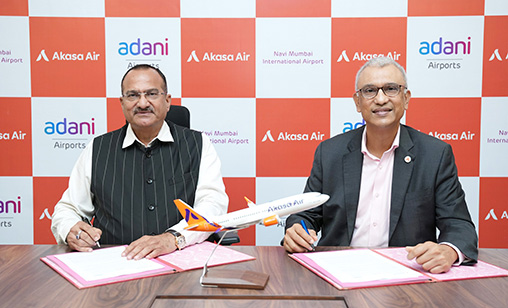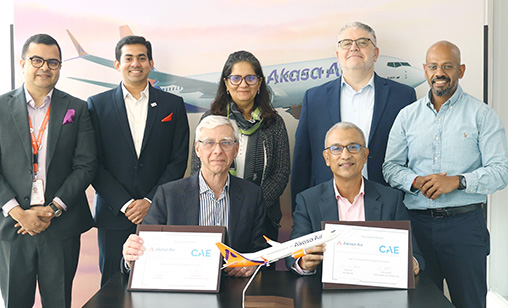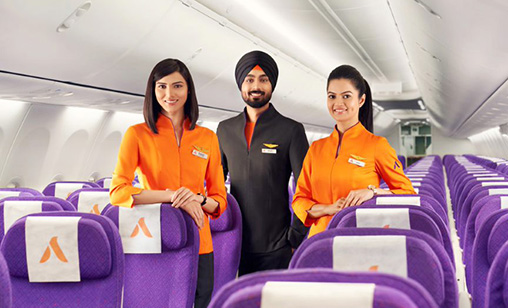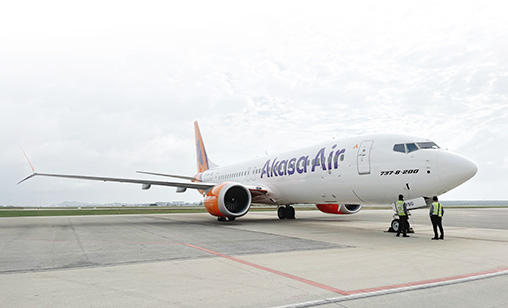Cover Story
The third wave
All eyes are on Akasa Air as an important barometer of India’s aviation health. Anjuli Bhargava reports.
August 1st 2025
In August 2022, as the global aviation industry was crawling out of the pandemic Akasa Air announced itself as a fully-fledged low-fare carrier to be launched in an increasingly crowded space. Read More » India’s aviation industry and its observers were aghast.
Almost everyone raised an eyebrow or two about the timing and even the need for “yet another carrier” in a sector where many participants were struggling as airlines shut down with unerring regularity.
 |
| 'The past has clearly shown us the fate of airlines in India is primarily in their own hands and very little to do with government actions or policy' |
| Vinay Dube Akasa Air CEO |
 |
But for Akasa founder, Vinay Dube, who had done stints at Jet Airways and Go First, and his team, it felt like an ideal time to take the plunge. They could see the market would rebound with a vengeance and that the sky was literally the limit especially for India with a population of 1.4 billion served by barely 600 aircraft at the time.
Not only could the India market support four to five strong players, they could thrive if run well as witnessed with market leader IndiGo.
This was precisely what Dube and his team set out to do. Three years after Akasa took off, they stand vindicated. And the proof of its success is its latest fund raising. At press time, the company had not released details of the additional funding, but the grapevine says US$125 million has been raised. It places Akasa in a stronger position as it convincingly overtakes rivals – thanks to some external factors - but largely because of strategic competence.
The airline has strong backers, including tech billionaire, Azim Premji of Premji Invest, Claypond Capital (Ranjan Pai’s family office) and 360 ONE Asset. A pat on the back has been an additional infusion of funds from the Jhunjhuwalas, the primary investor in the airline at its launch via a family trust that keeps its holding below 51%.
The fact Akasa has attracted marquee investors comes as no surprise. The airline’s aircraft induction has been on track, both swift and consistent. Its fleet has grown to near 30 aircraft in three years. No mean feat. It is one of the first airlines in the world to achieve this milestone. Compare Akasa’s acquisition of 20 jets in its first year with IndiGo’s 12. Other airlines in India such as Go First and AirAsia India took so long to reach the same milestones that a comparison is superfluous. In an era of low aircraft availability, Akasa has more than 200 aircraft on order, an initial 75 B737 MAX commitment followed by a 150 aircraft order.
Akasa has been helped by its rivals. They are in a state of flux. Air India is running well behind schedule in its proposed plan to take the leadership position in India aviation by March 2027.
IndiGo is shedding its original skin and emerging as a full-service player on the global stage.
Air India’s low-fare subsidiary, the merged entity of Air India Express and AirAsia India, is rejigging and transforming itself into a full blown copy of the IndiGo of the past. SpiceJet is struggling to stay afloat in a market full of uncertainties and well out of its control.
In 2019, Jet Airways shut shop followed by Go First in May 2023. Full-service Vistara has been subsumed into the Air India fold.
Besides the radically altered aviation landscape, the India market quickly shrugged off the gloom of COVID. India’s citizens started traveling with a vengeance as the pandemic threat declined. As well, oil prices - one of the industry’s biggest party poopers – are giving airlines a breather although the rupee remains volatile.
 |
So the future is looking rosier than the past has been. To Akasa’s clear advantage, the fact it launched without any of the pandemic baggage afflicting rivals helped it set the fastest pace of growth in a highly competitive market.
Many other parameters seem to slowly but surely be turning in Akasa’s favour. It is consistently reporting high loads with July load factor numbers at 90%, bettering both the mid-80s load factor at SpiceJet and IndiGo and sustaining that lead in the last several months. Cancellations and complaints are amongst the lowest compared with competitors. The outcome for Akasa is a 5% market share in a short period and quite high aircraft utilization.
A quick comparison with its closest rival, SpiceJet, is revealing. India’s Directorate General of Civil Aviation (DGCA) data of passengers affected by cancellations in July was 620 for Akasa against 6,675 for SpiceJet. DGCA said 8,901 Akasa passengers were affected by delays beyond two hours in the month compared with SpiceJet’s 21,202 passengers.
The airline also has delivered good on time performance, despite launching with a small fleet. Deployment of alternate aircraft is harder with a smaller fleet. Now, operating almost 30 aircraft, Akasa’s on time performance at six of the country’s major airports is 85%, second to IndiGo’s 91% but better than Air India’s 82% and far higher than SpiceJet’s 62%.
Taking a leaf out of IndiGo’s book, Akasa’s executive team has maintained a low profile focused on establishing the airline for the long-term unlike the founders of several rival airlines who are more focused on publicity and appearing in the news to tom-tom their purported successes. Keeping its head down has helped Akasa command a bigger market share today than SpiceJet, an airline that has been around since 2005.
It’s no-frills, efficient inflight service with clean and new aircraft and on time performance are the reasons for its high load factor. It also does not discount its fares.
 |
The airline’s route selection has mirrored IndiGo. “Akasa has been getting into a market, increasing frequencies to be number two or three in this aspect and connecting the dots within the network rather than opening new stations with one or two flights,” pointed out a former ministry of civil aviation secretary. “The advantages of not spreading oneself too thinly too early are many,” he said.
The airline also was quick to enter the international market and now operates to six international destinations without adding a new aircraft type to its fleet.
Several players in India’s aviation landscape have made a hash of such expansion, failing to understand the nuts and bolts of a network strategy despite having dollops of experience. The airline’s frequencies on some of the major routes, including Mumbai-Delhi and Delhi-Bengaluru, still remain quite low, a weak spot observes industry pundits.
Akasa justifies this situation on the grounds that slots are not easily available. But when the new airports at Navi Mumbai and Greater Noida are fully operational, this is likely to change quite rapidly.
According to industry experts and observers, there are two strong factors in Akasa’s favour, both of its own doing.
Firstly, the airline is mostly staffed by qualified staff with plenty of combined experience. Many of them have cut their teeth with full-service carriers, but they are aviation professionals through and through. This could be a distinguishing factor contributing to Akasa’s success, argue observers and experts watching Air India struggle with a senior management that is a hotch potch from several Tata run businesses.
One of the biggest factors working in Akasa’s favour is its staff focused policies. In an era when airline employees have many grievances and the relationship between management and staff has been turning quite hostile, Akasa seems free of this affliction, facing no large-scale discontent. While some in the industry attribute this to its relative newness, others argue it is a result of a very deliberate and focused policy.
 |
| Sustainability is the rule On almost every front, sustainability and environmentally friendly practices appear to be one of the carrier’s cornerstones. To cite a few instances: crew trousers and jackets are crafted using recycled polyester fabric derived from marine waste plastic bottles, all perishable meal packaging is 100% recyclable and made from paper ethically sourced from sustainably grown crops, uses biodegradable wooden cutlery on board. |
An airline insider said this “employee centric focus:” is being led by Dube himself who has seen Go First pay a very heavy price for its poor people management.
In a sector where it is presently rare to find pilots who are happy with their employers, Akasa is an outlier. Almost all the commanders to whom this writer has spoken said that despite one unpleasant face-off with its pilots in 2023, the LCC has the happiest cockpit crew with the airline optimizing career advancement for both first officers and commanders; Akasa has a 21 day work pattern with nine days off. The casual dress for crew - sneakers as opposed to heels to make their working shifts more comfortable -resonates well with younger fliers, with many choosing Akasa as the more “hip, with it” airline than the comparatively stodgy Air India. Recently, the airline started rewarding employees at airports with a system that recognizes exceptional on ground passenger handling.
Akasa is working to build the most “open” and democratic culture with easy access to management for all staff members.
Dube points out that at the airline’s Mumbai headquarters, no top manager has a cabin with access to a window just to himself or herself. “We have been careful to ensure everyone has a light filled space and the windows are not reserved for those with cabins,” he explained.
It may seem like a small matter, but several corporate offices tend to design spaces with the senior and top management in mind above all others.
Akasa has chosen to be as democratic as possible in its design. “The message is that people, our staff matter. This is consistent across functions”, a company insider told Orient Aviation.
A former Air India director said this factor could help Akasa steadily rise and retain the position of a strong number three in a market grappling with all the negatives of a duopoly post the sale of the national carrier in October 2021.
“Across airlines, this aspect has been ignored and disgruntled staff can be the reason for the downfall of any of the carriers in an industry that works on the harmonious and smooth blend of men and machines,” he said.
In a woke world, a lot of the airline’s sustainability initiatives resonate well with the younger fliers it seeks to attract. A set of sustainability initiatives have helped Akasa create the youngest and “greenest” fleet in India. It also is saving approximately 60,000 litres of water per aircraft with a host of tiny steps including being the first airline in India to forgo ceremonial water cannon salutes at flight and route inaugurations.
But it is not as if all is hunky dory at the carrier. Questions have been raised time and again about Akasa’s failure to turn a profit in an environment where IndiGo has been raking it in. Even Air India has managed to report a small operating profit for this fiscal year
 |
Akasa has high loads and the environment has been quite favorable with lower oil prices, a stronger rupee and robust traffic but Akasa continues to report losses.
Dube posits the losses are in line with the airline’s expectations and that the foundational years of any airline are dedicated to investing in its people, fleet, training, operating infrastructure and network and hence no airline registers profits in these years.
That the airline has yet to break even has not deterred its newest investors. “We remain very vigilant as aviation leaves no room for complacency,” Dube said.
Perhaps a bigger worry is it takes very little time for losses to tot up in India. There is perhaps no sector as susceptible to every kind of externality and to have so many variables to manage that remain out of an airline’s control.
A second red flag raised by sector analysts and experts is the airline appears top heavy. Comparisons with IndiGo might not be completely fair, but they are regularly voiced as the market leading LCC launched with a very lean team and maintained this approach until it went public.
While there is no denying, from a passenger point of view, that Akasa’s survival and well-being is far more significant today than in the months after its launch especially in an environment of negative sentiment about a duopoly that includes fare collusion, dismissal of passenger concerns and ad-hoc charges.
Industry sources argue that Akasa is “too small to matter” but that predatory pricing and other hurtful business tactics threaten any small fish in a big pond.
“Competition in the form of a minor irritant is often welcomed by the biggies. We will have to see what happens when Akasa reaches a sizable number of planes for the bigger players to notice it,” a DGCA former senior staffer noted. Competition can be aggressive even for talent within the industry, he said, and added Akasa has “shot itself in the foot once” when it decided to take its own pilots to court in 2023. Although Akasa has weathered and even emerged stronger from the experience, it has to make sure it doesn’t ruffle any more feathers, he said.
Although Dube and his team maintain the airline is well positioned for future crew requirements, industry sources claim after IndiGo began to re-hire and Tata’s have started luring crew, its crew recruitment rate became more challenging.
To counter future staff shortages, Akasa has established learning academies in Gurugram and Bengaluru, where it trains 750 employees a month.
“The airline’s investment in a 50,000 sq ft learning academy represents our focus on employee centricity and is a significant step in laying the foundation for building a long-term business,” Dube said.
As the Akasa team gears up for its next phase, whether the smaller boat steering through India’s choppy waters will be resilient or flounder will depend as much on the skills and abilities of the captain as on tempests of the seas.